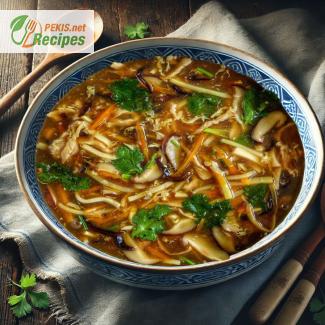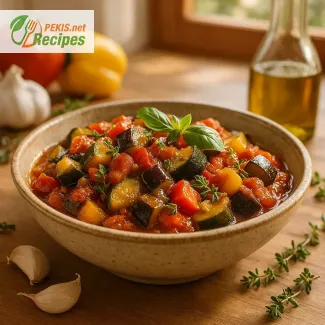
Step into the heart of Chinese culinary tradition with this original hot and sour soup recipe, a dish that has captivated taste buds for centuries. Bursting with bold flavors, this soup is a symphony of contrasts, blending the heat of spice with the invigorating tang of sourness. Its velvety broth, infused with aromatic seasonings and rich textures, offers an experience that’s as comforting as it is exhilarating. Perfect for warming up on a chilly day or impressing guests at your next gathering, this recipe is a celebration of everything that makes Chinese cuisine so universally adored.
The hot and sour soup is more than just a dish; it’s a sensory journey. Each spoonful introduces you to layers of complexity: the fiery kick of chili paste, the earthy depth of shiitake mushrooms, and the bright tang of rice vinegar. These ingredients are harmoniously balanced with silken tofu and tender slices of meat or vegetables, creating a hearty and satisfying dish. Its origins are steeped in history, believed to have been crafted as a restorative meal, making it a timeless staple in both Chinese households and celebrated restaurants worldwide.
What Makes This Soup Stand Out?
This hot and sour soup stands apart for its versatility and health benefits. It can easily be tailored to suit vegetarian, vegan, or gluten-free diets, ensuring everyone at your table can enjoy its robust flavors. Whether you prefer the classic pork-based version or a lighter vegetarian take, the result is always a bowl brimming with nutritional goodness and rich umami.
The key to its authenticity lies in the careful selection of traditional ingredients, such as wood ear mushrooms, bamboo shoots, and white pepper. These components not only elevate the taste but also provide a host of health benefits, including improving digestion and boosting immunity. Paired with the silkiness of egg ribbons and the satisfying crunch of fresh scallions, this soup offers a textural harmony that keeps you coming back for more.
A Culinary Masterpiece in Every Bowl
The beauty of this recipe lies in its simplicity and depth. Despite its sophisticated flavors, hot and sour soup is surprisingly easy to prepare. In just under an hour, you can create a dish that rivals the offerings of top-tier restaurants. The process involves creating a flavorful broth, layering it with high-quality seasonings, and adding fresh, wholesome ingredients. The result is a soup that not only delights the palate but also nourishes the soul.
This dish is ideal as a starter to a full-course meal or as a standalone delight for a quick yet satisfying dinner. Pair it with a side of steamed dumplings or crispy spring rolls for a truly indulgent dining experience.
Celebrate Tradition and Innovation
While this recipe honors its traditional roots, it also embraces modern culinary preferences. Whether you’re a seasoned chef or a home cook eager to explore new flavors, this soup is a perfect canvas for creativity. Adjust the spice levels to your liking, experiment with different proteins, or incorporate unique garnishes for a personal touch. Each variation adds a new dimension to this timeless classic, ensuring it remains a favorite across generations.
Why You’ll Love This Hot and Sour Soup
- Bursting with authentic Chinese flavors
- Quick and easy preparation without sacrificing depth of taste
- Customizable for various dietary preferences
- Rich in nutrients and naturally low in calories
- Perfect for any occasion, from weeknight dinners to festive feasts
Embrace the magic of Chinese hot and sour soup and transform your kitchen into a hub of flavor and aroma. This recipe is more than just a meal; it’s an invitation to explore a world of culinary delight, connecting you to the heritage and artistry of Chinese cuisine. Whether it’s your first time trying this dish or you’re revisiting an old favorite, this hot and sour soup promises to impress with every bowl.
- Prepare the Ingredients:
- Soak the shiitake mushrooms in warm water for 20 minutes, then slice them thinly.
- Cut the tofu into thin strips and julienne the bamboo shoots.
- Create the Broth Base:
- In a medium pot, bring the vegetable or chicken stock to a gentle boil.
- Add soy sauce, rice vinegar, sesame oil, and white pepper. Stir to combine.
- Add Main Ingredients:
- Add the sliced mushrooms, bamboo shoots, and tofu strips to the pot. Simmer for 5–7 minutes.
- Thicken the Soup:
- Gradually stir in the cornstarch slurry, ensuring there are no lumps. Let the soup simmer until it thickens, about 3–5 minutes.
- Add Egg Ribbon:
- Slowly pour the beaten egg into the soup in a steady stream while stirring gently to create ribbon-like strands.
- Garnish and Serve:
- Remove from heat and garnish with chopped spring onions and coriander leaves if desired.
- Serve hot and enjoy!
Enhancing and Customizing the Original Chinese Hot and Sour Soup Recipe
The beauty of hot and sour soup lies in its balance of flavors and its versatility. While the traditional recipe provides a robust and authentic taste, there are numerous ways to customize the dish to suit different palates, dietary needs, and ingredient availability. Below, we explore various adjustments and their impacts on flavor, texture, and overall presentation.
1. Adjusting the Heat and Spice
The "hot" element in the soup typically comes from white pepper and occasionally chili paste. Here are some ways to modify this aspect:
- Increase the Spice: Add fresh chili slices, chili oil, or chili flakes during cooking to intensify the heat. This enhances the soup's boldness and makes it more invigorating, especially for those who love a spicy kick.
- Mild Option: Reduce or omit the white pepper and chili paste. Instead, incorporate sweet paprika for a milder, slightly smoky flavor while retaining depth.
- Alternative Heat Sources: Use Szechuan peppercorns to add a tingling, numbing sensation, elevating the soup’s authenticity for fans of Szechuan cuisine.
Impact on Flavor: A spicier version brings warmth and excitement to the palate, while a milder soup allows the sour and umami notes to shine.
2. Enhancing the Sourness
The "sour" component is delivered through rice vinegar. Modifying the type or quantity of vinegar can alter the soup’s tanginess:
- Increase Tang: Add an extra teaspoon of rice vinegar or include a splash of black vinegar for a deeper, more complex sour profile.
- Alternative Vinegars: Use apple cider vinegar for a fruity undertone or balsamic vinegar for a slightly sweet and rich depth.
Impact on Flavor: Amplified sourness adds brightness and sharpness, balancing the richness of the broth, while alternative vinegars can introduce subtle new layers of flavor.
3. Adjusting the Protein
The recipe traditionally uses tofu for its silky texture. However, changing the protein source can transform the soup significantly:
- Meat Options: Shredded chicken, thinly sliced pork, or shrimp can be added for a heartier soup. The meat absorbs the broth’s flavors, enriching the overall experience.
- Plant-Based Alternatives: Use tempeh or jackfruit for a vegan version with added texture.
- Egg-Free Option: Replace the egg ribbons with finely shredded soft tofu or an additional cornstarch slurry for a creamy, cohesive texture.
Impact on Flavor: Adding meat deepens the umami, while plant-based options make the dish lighter and suitable for vegetarians or vegans.
4. Modifying the Vegetables
Vegetables contribute texture and visual appeal to the soup. Adjusting or adding vegetables can create interesting variations:
- Classic Vegetables: Bamboo shoots and shiitake mushrooms are traditional, but feel free to add wood ear mushrooms for an authentic crunch.
- Additional Vegetables: Add julienned carrots, bok choy, or napa cabbage for sweetness and a fresh, vibrant look.
- Seasonal Adjustments: Incorporate locally available mushrooms like cremini or portobello if shiitake mushrooms are unavailable.
Impact on Flavor: Adding more vegetables enhances the nutritional value and balances the soup’s richness with earthy or sweet notes.
5. Altering the Broth Base
The broth is the soul of the soup, and even minor changes here can dramatically influence the dish:
- Richer Base: Use bone broth or dashi stock for a deeper umami profile.
- Vegan Base: Opt for a miso-based broth or mushroom stock to achieve richness without animal products.
- Herbal Touch: Infuse the broth with star anise, ginger, or garlic for aromatic complexity.
Impact on Flavor: A richer broth creates a more luxurious feel, while herbal additions lend a nuanced, aromatic depth.
6. Adjusting the Texture
The texture of hot and sour soup is creamy yet slightly thickened. Changes in texture can enhance or personalize the dish:
- Thicker Soup: Increase the amount of cornstarch slurry for a more velvety consistency.
- Thinner Soup: Use less cornstarch or omit it entirely for a lighter, brothier result.
- Crunchy Elements: Top the soup with fried wonton strips or crispy rice for an additional layer of texture.
Impact on Flavor: A thicker soup feels indulgent and comforting, while crunchy toppings add contrast and excitement to every bite.
7. Garnishing Variations
While spring onions and coriander are classic garnishes, alternatives can add a unique touch:
- Herbal Options: Add fresh chives, Thai basil, or parsley for a different aromatic profile.
- Spicy Garnish: Drizzle chili oil or sprinkle with freshly ground Szechuan peppercorns for a punchy finish.
- Citrus Twist: A splash of lime juice or zest just before serving brightens the dish and enhances the sour notes.
Impact on Flavor: Garnishes provide a final layer of freshness, heat, or zest, tailoring the dish to individual preferences.
8. Adjusting for Dietary Needs
Customizing the recipe for specific dietary requirements can broaden its appeal:
- Gluten-Free: Use tamari or coconut aminos instead of soy sauce, and ensure the vinegar and cornstarch are gluten-free.
- Low-Sodium: Opt for reduced-sodium soy sauce and broth to make the soup heart-healthy without sacrificing flavor.
- Vegan: Replace the egg ribbons with a blend of silken tofu and nutritional yeast for a similar texture and umami boost.
Impact on Flavor: These adjustments retain the soup’s essence while accommodating dietary preferences, ensuring everyone can enjoy its rich taste.
9. Presentation Tweaks
While the soup’s flavor is its highlight, presentation can elevate its appeal:
- Serve in dark ceramic bowls to contrast with the soup’s vibrant colors.
- Add decorative drizzles of chili oil or soy sauce for visual intrigue.
- Sprinkle toasted sesame seeds on top for a touch of elegance.
Impact on Experience: Eye-catching presentation enhances the dining experience, making the dish as visually satisfying as it is flavorful.
The flexibility of hot and sour soup allows you to transform it into a dish that caters to your taste, lifestyle, and creativity. Whether you choose to intensify the spice, explore alternative proteins, or adjust the texture, each variation provides a new perspective on this timeless classic. Embrace these tips to make the soup your own while preserving its authentic charm.
- Contains soy (soy sauce, tofu) and egg.
- Gluten may be present in soy sauce; use gluten-free soy sauce as a substitute.
- For a vegan option, replace the egg with a cornstarch-thickened mixture of water and nutritional yeast.
- Vitamin C: 4 mg – Supports immune function.
- Calcium: 40 mg – Strengthens bones and teeth.
- Iron: 1.2 mg – Vital for red blood cell production.
- Potassium: 200 mg – Helps regulate blood pressure.
- Selenium (from tofu): 3 mcg – Protects cells from oxidative damage.
- Beta-glucans (from shiitake mushrooms): Improves immune response.
- Phenolic compounds (from bamboo shoots): Supports anti-inflammatory benefits.
Enjoy this wholesome, warming dish that balances flavors and nourishes your body!





